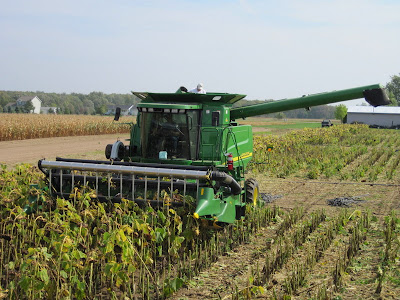So we are done with all of the tours and visitors. Well we won't turn away a worthy drop-by, but the scheduled ones are history. And here it is September already, and we start to think about harvest here in Michigan. But this summer has been a full one, such that we will all share a ton of memories. But we finally did get some rain on Wednesday night and Thursday, as well as last night and today. (This recent rain was not forecast, the weather was supposed to be clear and warm on this Labor Day.) Last week we got 1.75 inches, so with last night and today, we are probably more than triple the 0.6 inches we received in all of August. Much of the corn has turned brown and the soybeans have turned yellow or have dropped leaves all together, even though we have not received the amount of heat units for regular maturity. But when stresses arise, the plant is triggered into completing production of grain. But not all corn and beans have turned. Thanks to irrigation, we do have corn that is still growing towards maturity. We are still around 100 growing degree days short of that required for physiological maturity of corn.

But we also have dryland corn that is pretty much done, and all brown due to the lack of moisture. But there is this corn below that is under irrigation, and it is all done growing. What's up?? Well remember that corn I showed here several times that did not receive any planter fertilizer, and all along it was way behind the corn that did receive an in-furrow application of Pro-Germinator + Sure-K + Micro 500. This is what it looked like last Friday. All brown with dropped ears while the corn around it is still pretty much green. Even though it did not have sufficient heat units for the designated physiological maturity, it had grown all that it could considering it did not have sufficient nutrients. So it threw in the towel, and matured.

Here the kernels show black layer, indicating it's done growing.

This field of mid group II soybeans on Farm 5 are still green, but only because of irrigation.

It's easy to tell where our linear irrigation stopped. See, there is a barn and the original land owners house to the left of the picture, or we would have kept going. But we're nice.

These soybeans were collected in the area of the above picture. Irrigation makes quite a difference in a year like this. (For you Sooners and Wolverines, the irrigated beans are on the left.)

It might be kind of hard to see, but this field is sloped. The soybeans at the top of the slope, in the foreground, ran out out of water, and have dropped all their leaves. The beans going down the slope still had a little water, and the leaves have turned yellow. But the beans at the bottom of the slope, where the ground levels off and the soil is heavier, are still pretty green. They will benefit from this recent rain.

And I'm sure I have embarassed Stephanie here, but look at the soybean plant she is holding. This is from that irrigated piece above, but was growing on the edge of the field kind of by itself. It has over 100 3-bean pods on it. And the base of the plant is thick and woody like a tree. Don't you wish you could have a field of beans like this? Of course you wouldn't want anyone else to have a field like this, as bean price is pretty good right now.

So it's nice just to be able to drive around the farm and see what is going on, and now we both know. (P.S. my fertilizer mission mentioned last time got rained out, but I'm not telling where.)
Happy Birthday Phil on Tuesday.....and Happy Birthday on Wednesday to Elyse!!!
 The conditions were good for Navy bean harvest, as there was enough moisture in the beans that we did not have any problems with splits, as the picture below shows.
The conditions were good for Navy bean harvest, as there was enough moisture in the beans that we did not have any problems with splits, as the picture below shows.









































